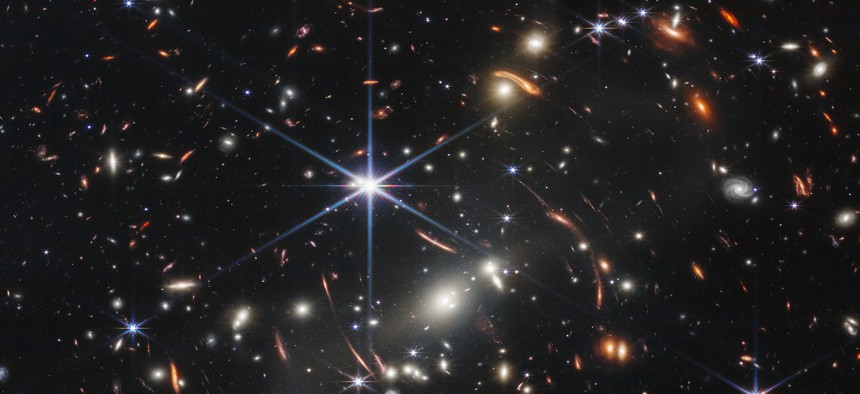Webb Proves a Remarkable Technological Successor to Hubble

NASA, ESA, CSA, STScI
The first pictures NASA released from the James Webb Space Telescope demonstrate—in brilliant color—the advancements made in the technology.
It doesn’t take a rocket scientist to see the advancements the James Webb Space Telescope has made in capturing information about the universe. The pictures speak for themselves.
But even NASA scientists, speaking at a July 12 press conference, described highly emotional reactions to seeing the data from JWCC begin to come in.
“The first focused images that we took, where they were razor sharp, that for me was the one where I had the very emotional reaction of ‘oh my goodness, it works, and it works better than we thought,’” said Jane Rigby, a scientist at the NASA Goddard Space Flight Center’s Webb Operations Project. She described the specs for Webb as orders of magnitude more sensitive than other telescopes. “How could you not discover stuff, if you’re 100 times more powerful than previous telescopes?”
For the layman, that sensitivity can be seen in comparing Webb’s pictures with those taken of the same parts of space by the Hubble Space Telescope.

Credit: NASA, ESA and the Hubble SM4 ERO Team

Credit: NASA, ESA, CSA, STScI
“For me it is like seeing Hubble again, but actually better because we have this coverage that overlaps with Hubble, and we are even sharper than Hubble there. This is, again, seeing the universe in a new way,” said Eric Smith, a scientist with the Goddard Space Flight Center’s James Webb Space Telescope Observatory Project.
Some have called JWST the replacement for the Hubble telescope—first launched in 1990 and still in operation today—but, according to the NASA fact pages, that characterization isn’t quite right. It’s more of a successor.
Hubble’s capabilities primarily see visible and UV light, though it has a small amount of infrared capability. JWST will focus mainly on that infrared spectrum, which enables it to focus on “highly redshifted” objects that are more distant and obscured by dust clouds.
“There’s just so much more detail,” said Amber Straughn, deputy project scientist at the Goddard Space Flight Center’s James Webb Space Telescope Observatory Project. “It’s like seeing in high-def.”

Credit: NASA, ESA, and The Hubble Heritage Team

Credit: NASA, ESA, CSA, STScI
JWST can also turn the data around in just a few days, where it might take Hubble much longer.
Part of the turnaround time comes from where the telescopes are located. Hubble orbits close to Earth at an altitude of about 570 kilometers. That location made it accessible for service during the shuttle program, but also means that its focus is more limited. JWST is approximately 1.5 million kilometers from Earth, even further out than the moon.
“Hubble is on the low orbit, so it cannot observe a transiting event very continuously, and so you need to have several visits, and that’s very inefficient. To obtain this kind of quality data with Hubble would take 10, 15 times more data. So, Webb will be absolutely revolutionary in that respect,” said René Doyon, principal investigator for the Near-Infrared Imager and Slitless Spectrograph, one of Canada’s contributions to the JWST.
And with space telescopes, size does matter. Webb’s mirror is bigger—approximately 6.5 meters compared to Hubble’s 2.4 meters—giving the telescope around 6.25 times more collecting area, according to NASA.

Credit: Hubble Heritage Team (STScI/AURA/NASA/ESA)

Credit: NASA, ESA, CSA, STScI
Aside from beautiful pictures, Webb’s enhanced technology also gives researchers new eyes for looking at the universe.
“What do we see [with Webb] that Hubble doesn't see? … Webb sees molecules, it sees chemistry. Hubble mostly sees atomic gas,” said Klaus Pontoppidan, a scientist at Goddard Space Flight Center’s James Webb Space Telescope Observatory Project. “So, what you are looking at is different energies, different temperatures. So, Hubble sees very hot stuff, Webb sees the colder stuff, and this is where we transform the gas from this hot atomic gas to one that creates molecules.”






